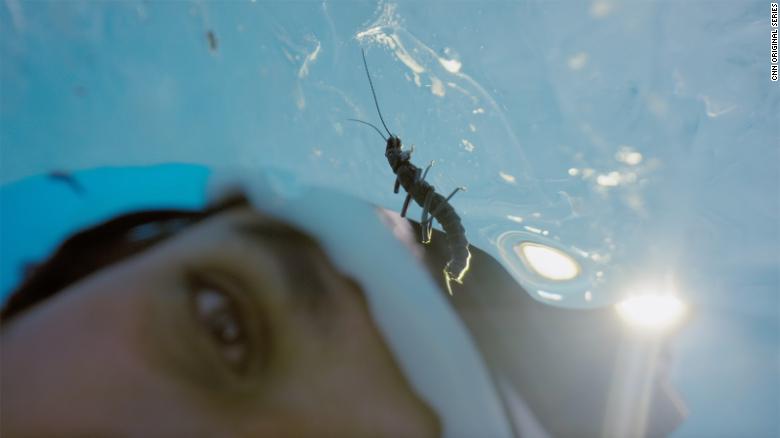(CNN) --
A mysterious and tiny dragon lives among the ice of the Andes mountain range in South America, and if you blink, you might miss it.
The Patagonian ice dragon is an insect that is just over a centimeter long (1.3 cm) and lives in glaciers.
Glaciers are melting much faster than expected, according to a new study
The Southern Ice Field of Patagonia is an impressive reserve of fresh water, but the ice rivers are a difficult place to inhabit.
The Patagonian dragon, a type of stonefly, has adapted to survive in this frozen land.
The dragon is what scientists call an extremophile, meaning an organism that can live in extreme environments.
This stonefly is the only true insect that lives in the Patagonian ice field, and its entire life cycle takes place on the ice.
Two species of ice dragon are known,
Andiperla morenensis
and
Andiperla willinki
, but there could be more waiting to be found.
That is all that scientists know, according to biologist Isaí Madríz.
Everything else is hypothesis or speculation.
advertising
But there are more questions than answers about the ice dragon.
tiny but mighty
Time may be running out for the ice dragon.
This tiny insect is in danger of extinction because the ice sheet it calls home is rapidly melting due to global warming.
Madríz is determined to learn as much as he can about the dragon, and to share that knowledge with others, to better understand a rare creature that learned to survive in a frozen and barren landscape millions of years ago.
Madríz, often called the "bug detective", has spent years researching the biodiversity of Patagonia.
As well as being the world's expert on the primitive crane fly, he investigates little-known lineages of insects.
Ice dragons live their entire life cycle in glaciers.
During his periodic expeditions to the ice field, Madríz began collecting observations of the ice dragon and sharing them with laboratories studying the species in Argentina and Chile.
"I'm upside down on the ice, moving forward looking at the insects and following them," he says.
"It's like going back to when you're a kid, looking at bugs and figuring out what they do."
They create a highway of 150,000 hectares for the "traveling" insects of the United Kingdom
the insect detective
Your detective work has paid off.
Until now, Madríz has been able to observe behaviors of these insects that can only be witnessed in the field.
He has also seen ice dragon eggs up close, a rarity as young ice dragons have proven elusive.
"The amazing thing is, once you start looking inside the eggs, it looks like it's a little shrimp," Madríz said.
"You can see the whole organism already developed."
By the time the female ice dragon lays her eggs, the insect hatchlings are fully formed.
Scientists don't yet know how long it takes to hatch, but their invisible nature is now understood: young ice dragons are translucent.
On ice, they are impossible to see until they begin to grow and mature and their exoskeletons become darker.
Madríz also learned by accident that ice dragons can withstand another extreme.
To preserve and study specimens, scientists often briefly boil them in water, which helps maintain the shape without collapsing the tissues.
Madríz plunged three ice dragons into boiling water for about 10 to 15 seconds and turned to do something else.
When he returned, one of the ice dragons was crawling out of the plate.
"We're going to find that this species is much more interesting than we thought, because you don't go from freezing to boiling water and survive, with the exception of something like a tardigrade," he said.
Microscopic tardigrades have the ability to survive and even thrive in the most extreme environments.
Space X is ready to launch baby squid and "water bears" into space
outstanding questions
Madríz hopes that many answers about the ice dragon will be revealed in the coming years.
He wants to find out how these insects chose to make their home in glaciers, rather than water, and then adapted to a unique lifestyle.
Madríz and his fellow researchers work tirelessly to unravel the ins and outs of the species, including how it survives in the ice field and what it eats.
It is currently speculated that ice dragon blood contains glycerol, a natural antifreeze, but the amounts and whether it prevents the insect's blood from freezing are unknown.
Future research could clarify this.
Ice dragons may feed on small algae in the ice.
They may also eat other insects that live in nearby valleys and are blown to glaciers and die there.
And ice dragons are known to feed on cryoconite, the fine powder of ice made up of microbes and other tiny particles.
This windblown dust can land on glaciers and decrease their reflectivity, which can facilitate their melting.
'Definitely a concern': Scientists worried about rapidly melting Greenland ice
"When you find the only (insect) that can live in that environment, then it has to have some impact on the environment," Madríz said.
Madríz wants to start a captive breeding program in the next two years to help save this insect before its ecosystem disappears.
Madríz hopes that raising awareness of this mysterious creature can make its conservation self-sustaining.
Getting field guides to teach tourists about ice dragons can also help educate travelers exploring Patagonia's disappearing glaciers.
Instead of searching for the best selfie opportunities on the ice, visitors can come in search of the elusive ice dragon and walk away with an understanding of an incredibly unique ecosystem, Madríz said.
InsectsPatagonia





